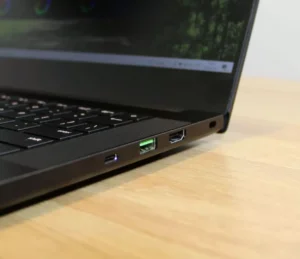How to Use a Laptop as a Second Monitor in Windows – If you need a second PC monitor for certain tasks, and in addition to a computer, only a laptop is available, there are ways to use it as a second monitor.
This guide details how to make a laptop a second PC monitor in Windows 11 or Windows 10 in several ways.
Connecting a laptop as a second monitor
- HDMI and USB
- Wireless display
- Spacedesk
HDMI/USB cable connection
Several times the question was asked: “Can I just connect a laptop via HDMI and use it as a second monitor?” To this, I would like to clarify:

- In most cases, a “simple” connection will not work – almost all laptops have an HDMI output, but it cannot work as an input.
- There are some rare laptop models equipped with an HDMI input, in particular, several Dell Alienware models (M17x, M18x, R4, 18).
- There is still a cable connection method, but it requires the use of additional equipment.
Separately, on the last point: if you want to use a cable connection, you can do the following:
- Purchase an inexpensive HDMI video capture device. Even better – a device with the fastest possible connection interface; it can be USB 3.0 or USB 3.2 Type-C (if the laptop has the appropriate connector). But such options will be more expensive: their cost is comparable to the price of inexpensive monitors.
- The video capture device is connected with a cable or USB connector to a laptop and an HDMI cable to a computer.
- For a computer, the connected device will be defined as a second monitor, and for a laptop – as another webcam: by opening any application on a laptop to view images from a webcam (including the built-in Windows one, it has the ability to select a camera), you will receive an image transmitted from a PC, and opening it to full screen is an analog of a second monitor on a laptop.
Remember that when using this method in combination with inexpensive devices, you will experience limitations in terms of image resolution (1920×1080), sometimes frame rates, and compression artifacts.
At the same time, purchasing a more expensive video capture device just for this purpose may not be justified – as noted above, it may be more reasonable to purchase a second monitor.
Wireless Wi-Fi connection (Miracast)

If your PC is equipped with a Wi-Fi adapter, you can try connecting your laptop as a second monitor using the Wireless Monitor feature. This option is available in both Windows 11 and Windows 10.
The procedure will consist of the following simple steps:
- On a laptop, enable computer projection. In Windows 11 and Windows 10, you can do this in Settings – System – Project to this PC. You may also need to install the Wireless Display add-on in Settings – Applications – Optional components – Add a component – Wireless display (but it may already be installed).
- On the computer you’re connecting from: In Windows 11, press the Win+K keys and select a laptop to connect as a wireless display; in Windows 10 – press Win + P, then below – “connect to a wireless display” and select the laptop you want to connect to. You can also select “Connect to a wireless display” in the display options.
- By default, the image will be duplicated; to change the mode of the second monitor, press the Win + P keys on the PC and select the desired option.
Spacedesk

Spacedesk is a program that allows you to use a laptop (as well as another PC or tablet) as a second monitor over a network, regardless of the type of connection. At the same time, the version for Windows computers is totally free.
To use it in the context of the topic of the article, it is enough to follow the following steps:
- From the official website https://www.spacedesk.net/ download and install the Spacedesk Driver for the computer to which the laptop will be connected as a second monitor and the Spacedesk Viewer for the laptop (can be downloaded from the Microsoft Store).
- After installing and running Spacedesk Driver, its icon will appear in the Windows tray. Once opened using the Spacedesk Driver Console icon, make sure the driver is enabled (under Control), and note the IP address of the network adapter.
- In Spacedesk Viewer on the laptop, connect to the IP address from the previous step.
- As a result, a window will open on the laptop, which for the PC will be the second monitor, and displayed in the monitor settings. If required, the window can be expanded to full screen.
There are other programs for the same purpose. One of the more popular options is Duet (duetdisplay.com), but unlike Spacedesk, it’s not free.
If you know other options for connecting a laptop with a second monitor to a PC, it will be great if you share them in the comments – the information may be helpful to other readers.
Conclusion
In today’s fast-paced digital environment, having additional screen real estate can significantly enhance productivity and provide an improved multitasking experience. Using your laptop as a second monitor is an innovative solution, saving you the need to invest in a new display. Whether you prefer a wired connection using HDMI and USB, the seamless experience of a wireless display, or the flexibility and functionality of Spacedesk, there’s an option suited to your needs.
The methods we’ve discussed not only optimize the utilization of your available gadgets but also provide a more immersive computing setup. No matter which approach you choose, expanding your workspace has never been so accessible and straightforward. So, breathe new life into that old laptop and make the most out of your digital workspace.


